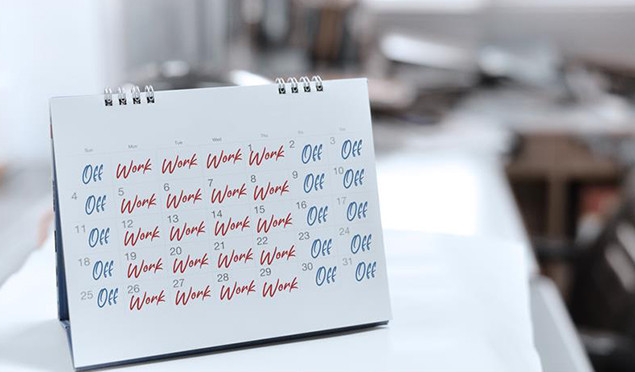Is it time to rethink the five-day week?

Published on 7th September, 2021 at 03:18 pm
The Monday-to-Friday nine-to-five routine is nearly a century old. Is it time to re-examine how long we’re spending at our desks?
In March 2021, Spain was poised to become one of the first countries in the world to trial a four-day working week. “With the 32-hour week, we’re launching into the real debate of our times,” tweeted Íñigo Errejón of Más País, the leftwing Spanish political party that had proposed the national pilot project. “It’s an idea whose time has come.”
The four-day working week’s time may have come, but it also arrived at the perfect confluence of technology and public health crises. Prior to 2020, it would have been difficult to believe we could have achieved such a seemingly overnight shift away from the traditional office and its concomitant structures. Now, with the rise of remote work and a renewed focus on the value of our health and time, are we ready to take another groundbreaking step towards a better work-life balance?
If you’re finding it challenging to switch off after a day’s work when working from home, these tips can help.
A changeable status quo
Anything that could threaten productivity or profit is anathema to business. However, a growing body of research supports the idea that a shorter working week could be beneficial to both employer and employee.
The American Journal of Epidemiology, for example, surveyed more than 2 200 Brits and discovered that those who worked 55 hours as opposed to 40 per week scored lower on tests measuring cognitive functioning. Presenteeism may keep staff at their desks, but they’re likely to be less effective the longer they’re there.
“There are compelling arguments for a four-day working week,” says integral coach and industrial psychologist Kim Conradie, who has more than 18 years’ experience in human resources. “Benefits to the organisation could include:
• Reduced absenteeism
• Less time off for personal days
• More efficient and productive employees
• Highly focused staff with a healthy level of stress and pressure
• Employees becoming more committed and aligned to organisation goals
• Increased retention and lower attrition rates of scarce-skilled employees and top performers
• Becoming a highly attractive employer to new talent
• Aligning to global best practice.”
Examples from around the world
Microsoft, Japan
Japan has the rather ignominious reputation of being a country of morbidly overworked citizens. They even have a unique word for this: karoshi means ‘death by overwork’, and refers to the many cases of fatal heart attack and stroke caused by occupational stress. Yet, in August 2019, Microsoft Japan became one of the first major international players to trial a four-day working week. The company reported glowing results from its month-long experiment.
• Productivity (sales per employee) rose by 40% compared to August of the previous year.
• Electricity consumption dropped by 23%.
• Staff printed 59% fewer pages.
• 94% of employees reported being happy with the programme overall.
Perpetual Guardian, New Zealand
The 240-strong New Zealand financial services company Perpetual Guardian ran a similar trial a full year earlier. It proved a “resounding success” according to the Auckland University of Technology research team that oversaw the project and its results, and the company officially instituted a four-day week following these results.
• Productivity remained the same as during a five-day week.
• Employee engagement levels increased.
• Individual stress levels came down moderately.
• Employees reported an improvement in work-life balance.
Software Delsol, Spain
The southern Spanish firm trialled the four-day week in 2020. The company reported:
• A reduction in absenteeism.
• Increased productivity. And
• Happier workers overall.
Surprising benefits of a shorter working week
The potential benefits of the four-day working week go beyond employee and employer, and into the realm of climate change.
• As demonstrated at Microsoft Japan, consumption of electricity and other resources could be cut significantly.
• Staff commutes, whether in vehicles or on public transport, would also be down by as much as 20% for offices that aren’t yet fully remote.
• A four-day working week could signal good news for the gender pay gap, too. Fewer working hours per week would be a boon to women (who make up a disproportionate percentage of people unemployed due to childcare responsibilities) hoping to get back into the workforce.
Read this for useful ergonomic tips to improve your workplace wellness – whether at home or the office.
Alternatives to the 40-hour working week
Monday to Thursday/32-hour working week
Pro
Healthier, less stressed employees who have a better work-life balance and increased engagement with their work.
Con
Potential loss of productivity if more efficient systems are not adopted. Potential loss of business for companies with a customer-service-based model (though some have already had success in this respect with creative scheduling of teams).
Midweek break
Pro
Having a Wednesday off allows employees to schedule medical appointments and other ‘life admin’ outside of working hours without taking leave, which is beneficial for the company. Weekends can then be dedicated solely to relaxation and family time.
Con
Interrupts the flow of the working week. Could be frustrating for suppliers or collaborators not on the same schedule.
Compressed working week
Pro
An ordinary 40-hour working week, compressed into fewer days, means longer weekends without the dip in hours – a work-hard, play-hard approach.
Con
Longer hours per day could increase stress, and negatively impact productivity and cognitive functioning.
If you’re looking to find the right balance of working from home and the office, read this.
The evolution of the weekend
We won’t scar you with talk of the ancient Babylonians’ seven-day, 100-hour working week. Instead, let’s skip to early 19th-century Britain.
19th century
British factory owners, tired of Monday absenteeism following their workers’ one day off per week, brought the start of the weekend forward to 2pm on Saturday. They reported increased productivity, with staff who showed up on Monday mornings sober and ready to perform.
20th century
The notion of a full two-day weekend as we know it today began to take hold in the early 20th century. This was thanks to a combination of factors that included the Industrial Revolution, the rise of trade unions, and greater recognition of sabbaths belonging to religions other than Christianity.
1926
The weekend was most notably championed by Henry Ford, who gave his workers Saturdays and Sundays off from as early as 1926. A shrewd capitalist, Ford knew that an extra day in which workers could spend their wages would keep cash circulating in the struggling 1920s high streets. It also resulted in fewer redundancies at factories that could no longer afford to keep depression-era workers on full time. However, it wasn’t until the 1930s that the US and UK signed the five-day working week into legislation.
Struggling to unwind at the end of a long day at your home office desk? We have a benefit for that! Reality Club, Core, Plus and Health members, enjoy up to five months’ Showmax streaming on us! Activate your benefit here.
Get on the flexitime train
Here’s how to approach your manager for a more flexible working schedule.
Know what you want before you ask for it
“Most organisations are still stuck in the traditional way of working and, sadly, most workplaces are quite infantilised,” says Conradie. “It will be your job to convince and prove to them that this can be done. When we do due diligence, we speak from a place of authority and, more importantly, confidence.”
Be realistic
“Before talking to your manager, be honest with yourself about your own capabilities and whether you will be able to fulfil your job requirements in adjusted hours. Do not set yourself up for failure.”
Prepare a plan
“This will be an adjustment for all involved, so put together a proposal on how you see this rolling out and what measures can be put in place initially to keep you and your outputs on track. Show that you have done your homework and that you believe in yourself.”
Focus on the benefits for them
“Avoid making the proposal about you and your personal circumstances. Rather focus on your ability to be able to successfully do this in the best interest of the organisation too.”
Know where to compromise
“Be prepared to offer to do this as an initial trial before settling on a more permanent arrangement. Try to keep the flexitime consistent rather than changing this as you go along, which will be a sure cause of exhaustion all round.”
Use your free Personal Assistant in the Sanlam Reality App to make the most of the hours in your day, and help you tick off your to-do list. T&Cs apply.
Want to learn more?
We send out regular emails packed with useful advice, ideas and tips on everything from saving and investing to budgeting and tax. If you're a Sanlam Reality member and not receiving these emails, update your contact details now.
Update Now







